G2208
Climate Change: What Does It Mean for Nebraska?
Weather trends are studied to determine what climate changes are occurring across the U.S. This publication describes trends found in Nebraska.
Martha D. Shulski, Director of High Plains Regional Climate Center
Natalie A. Umphlett, Regional Climatologist
Tapan B. Pathak, Extension Educator
Kenneth G. Hubbard, Extension Climate Resource Specialist
- Setting the Stage — Nebraska’s Variable Climate
- Why Does the Climate Change?
- What Are the Current Trends for the Globe and the U.S.?
- Weather vs. Climate — What is the Difference?
- What Does Future Climate Change Mean for Nebraska?
Setting the Stage — Nebraska’s Variable Climate
Because Nebraska’s location on the North American continent is far removed from large bodies of water, Nebraskans experience a strong continental type climate. As such, residents do not benefit from the moderating influence of the ocean, and temperatures can have wide swings from day to day and season to season. Typical characteristics for a continental climate at this latitude are large temperature variability with warm summers dominated by convective thunderstorms, and cold winters influenced by snow and wind from mid-latitude cyclones.
From east to west across the state there is a considerable difference in climate, particularly for precipitation and humidity. The eastern half of the state receives moisture from southerly winds coming across the Gulf of Mexico. The western half usually cannot benefit from these moist southerly winds; therefore, it is much drier on average and less humid. Annually, precipitation ranges from more than 30 inches in the east to approximately 15 inches in the west.
Systematic weather observations began in Nebraska in the late 1800s. By looking at a long history of observations, we are able to identify variability in climate and changes over time. When this is done, particular time periods stand out in the historical record. For example, notable warm periods in Nebraska occurred in the 1930s as well as the late 1990s and early 2000s (Figure 1). In fact, 2012 was the warmest year on record for the state. For precipitation, the 1930s dry period is clearly evident and stands out as having several years with significant annual departures. However, it was 2012 that recorded the driest year on record (Figure 2). Periods of above average precipitation are also evident in the historical record, such as the 1980s. If we look at changes over time, we see that since 1895 the average annual temperature in Nebraska has increased by about 1°. Annual precipitation statewide since 1895 does not seem to have a discernible trend, however.
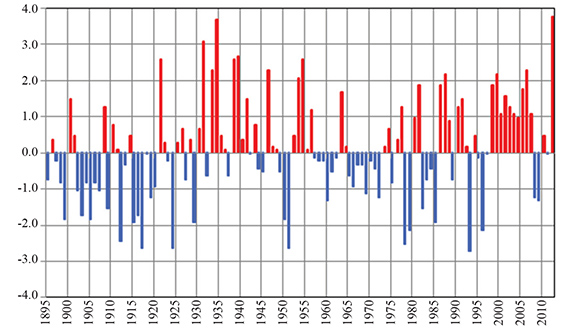 |
Figure 1. Annual average temperature in Nebraska, shown as a departure (°F) from the 20th century average. |
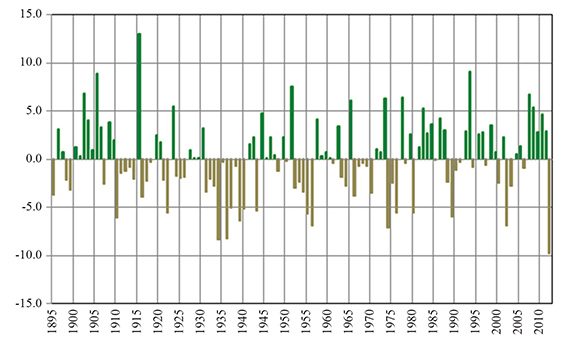 |
Figure 2. Annual total precipitation in Nebraska, shown as a departure (inches) from the 20th century average. |
These graphs illustrate the fact that conditions can vary a lot from year to year in Nebraska. This is because of the continental nature of Nebraska’s climate. One could say that the historical variability is greater than the detected long-term trend, or change in the state of the climate, since the trends have been relatively small in comparison to the year to year variability. Why, then, should we care about a change in climate, particularly for the future, and why does it matter to us? Will we experience a shift toward warmer, colder, wetter, or drier conditions that will cause noticeable shifts in the growing season conditions? This publication attempts to answer some frequently asked questions about changes in climate, such as the cause, regional vs. global change, weather vs. climate, and the impacts of a changing climate in Nebraska.
Why Does the Climate Change?
The Earth’s climate has changed throughout history and will continue to change in the future. Global climate change can be attributed to natural and anthropogenic (human) causes and can occur on both short-term and long-term time frames. A volcanic eruption is an example of natural short-term climate change. When ash is ejected into the atmosphere, it temporarily blocks a portion of the incoming sunlight and subsequently cools the earth. Powerful volcanic eruptions that reach the stratosphere, such as Mt. Pinatubo in 1991, can decrease the global average temperature by nearly 1° for one to two years. Other powerful eruptions have occurred in recent history and have changed the global climate. The Krakatoa eruption of 1883 led to cool conditions and global weather pattern disruption for several years, and the Tambora eruption of 1815 led to what is known as the year without a summer in the northern hemisphere.
El Niño and La Niña oscillations are good examples of natural short-term causes of variability in the climate system. When the sea surface temperatures in the equatorial Pacific are warmer (El Niño) or colder (La Niña) than normal, global wind patterns change, which in turn affects temperature and precipitation patterns around the globe. Nebraska typically does not experience as strong an influence from these events as compared with other areas of the U.S., such as the west coast and the southeast. These patterns run in cycles that can last a few years.
Climate also changes on a much longer time scale, i.e., cold glacial periods and warm interglacial periods in the geologic past. Long-term climate change, on the order of thousands of years, is caused by variability in Earth’s orbit and resulting changes in the amount of solar radiation we receive. From analyzing concentrations of carbon dioxide (CO2) in the air bubbles trapped in Greenland and Antarctic ice, and other types of proxy records such as tree rings and deep sediments, we know that Earth’s temperature has varied by several degrees in the past, causing long periods of warm and cold global climates. Currently, we are in an interglacial period after coming out of the last ice age about 10,000 years ago.
Human activities are also known to influence climate, and we do this by changing our environment. Many of us have experienced this influence on a local scale. For example, when cities are constructed the natural surface features are altered significantly. Materials such as concrete and asphalt absorb sunlight and release the heat back into the atmosphere as thermal energy, causing the well-known urban heat island effect. This is unlike vegetation, which absorbs sunlight and also has the benefit of using water for transpiration, which generally results in a lower surface temperature. Another way in which we alter our environment and influence climate is by irrigating a crop field. The addition of water increases the rates of evapotranspiration in the area. This increases the moisture in the atmosphere and changes humidity, which can result in warmer nighttime conditions. These examples demonstrate how changes in land use or land cover influence climate but the effects are mostly felt locally or regionally.
The human influence that currently gets the most attention in the press is the increasing levels of greenhouse gases in the atmosphere. Greenhouse gases contribute to a general warming of the Earth as their concentrations rise. There is a natural greenhouse effect that occurs on Earth, without which the temperature would be an inhospitable 50 degrees colder. The issue in recent decades is an enhancement of this greenhouse effect.
The term “greenhouse effect” is a misnomer because a true greenhouse does not allow for any natural airflow; however, greenhouse gases in the atmosphere (carbon dioxide, water vapor, methane, nitrous oxide, and others) act somewhat like the walls and ceiling of a greenhouse. The gases are essentially transparent to incoming solar radiation, or shortwave, which is allowed to pass through the atmosphere and reach the surface. However, the problem is with thermal, or longwave, radiation that Earth emits. The amount of radiation Earth emits is a function of surface temperature. Greenhouse gases absorb this emitted thermal radiation and re-emit it back to Earth, and this results in increasing surface temperatures. These gases have a relatively long lifetime in the atmosphere (about a century for CO2) and are well distributed throughout the global atmosphere. Because of the long lifetime and wide distribution, global temperatures are influenced by an enhancement of the greenhouse effect, even though greenhouse gas production happens at the local or regional scale. There are many sources for these gas emissions, such as the burning of fossil fuels and industrial processes.
The greenhouse gas that has received the most attention is carbon dioxide (CO2), although water vapor is the highest concentration greenhouse gas. The influence of CO2 on atmospheric temperature was first recognized by a Swedish scientist in 1895. Systematic and continuous observations taken at a high altitude location in Hawaii beginning in 1958 (referred to as the “Keeling Curve” after the scientist who supervised the measurements) show steadily increasing CO2 concentrations in the atmosphere since this time (Figure 3). The observations also show seasonal variability consistent with the annual cycle of vegetation growth and dormancy patterns. The current concentration of CO2 has reached 400 parts per million (ppm), with an increase per year of 2 ppm in the last decade. This level is much higher than previous interglacial time periods as shown from ice core records, and a significant increase in CO2 is evident around the time of industrialization. In fact, records show that CO2 concentrations have not exceeded 280 ppm during the past 600,000 years. Global climate models use CO2 as a primary forcing on the climate system when projecting future climate change.
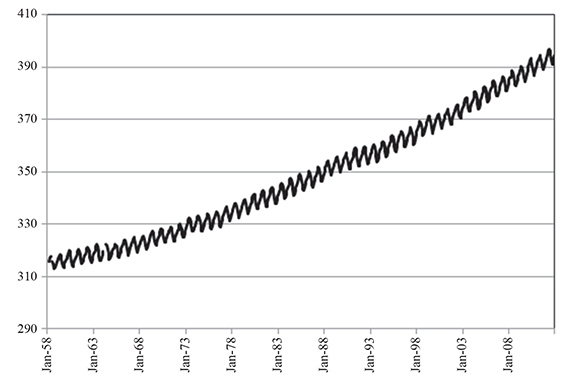 |
Figure 3. Carbon dioxide concentration (parts per million) as observed at Mauna Loa Observatory, Hawaii. |
What Are the Current Trends for the Globe and the U.S.?
Surface temperature measurements of both the land and the ocean indicate a warming trend since the early 20th century and especially in the last 50 years. Figure 4 shows the temperature anomaly (departure from the 20th century average) for the global mean temperature over land and ocean for each year from 1880-2012.
In the contiguous U.S., temperatures have risen about 1.3°F over the past 100 years; however, this represents the average and the trends are not the same across the country (Figure 5). While a majority of the U.S. has experienced a warming trend, a few areas experienced a cooling trend. Areas that experienced cooling include parts of the southeast. Meanwhile, other areas such as the southwest, west, northern Great Plains, and parts of Alaska have experienced temperature increases of more than 2°F during the last century.
This illustrates that climate change is generally not uniform over a large area. Even though the U.S. on the whole has seen a one-degree rise in temperature, the change for individual areas is not necessarily one degree as well. These regional differences are simply the nature of the climate. Factors such as land use, prevailing winds, storm track, and ocean conditions, among others, all come into play at the regional and local scale. This lack of uniformity also holds true for the globe. The Arctic, for example, has warmed more than 3°F in the last century, while the tropics have warmed less than 1°F.
If daytime high and nighttime low temperatures are looked at separately, the warming trend is greater, in general, for the lows than the highs. This is the case for much of the globe, with nighttime lows warming more than daytime highs. One reason for this difference is thought to be an increase in the amount of moisture in the air, which influences low temperatures more than highs. If broken down by season, the warming is strongest in winter and weakest in autumn. This seasonal variability is also evident in the global trends, particularly for land areas in the high latitudes of the Northern Hemisphere, which are warming the most.
For precipitation, the annual total for the U.S. increased 6 percent in the last 100 years. However, variability from region to region is high and some areas, such as Hawaii, experienced a significant decrease in precipitation. On the other hand, places such as the south experienced significant increases in precipitation. Globally, there is much less uniformity for precipitation trends than for temperature.
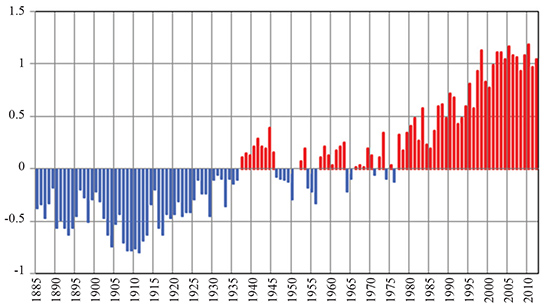 |
Figure 4. Annual average temperature for the globe, shown as a departure (°F) from the 20th century average. |
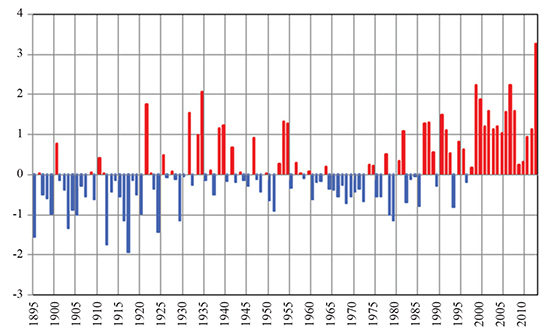 |
Figure 5. Annual average temperature for the contiguous United States, shown as a departure (°F) from the 20th century average. |
Weather vs. Climate — What is the Difference?
You might be wondering, “We had a cold spell this winter with record low temperatures and heavy snowfall. How can the planet be warming?” These two events (record cold days for one location and global climate change) are related, but they are not the same phenomena. The short-term event is an example of weather, while the long-term change is an example of climate. Often the terms “weather” and “climate” are used interchangeably among the public, though they do not have the same meaning.
Weather describes the state of the atmosphere (cloudy/sunny, hot/cold, wet/dry, etc.) at a particular time. The time frame for weather is in hours and days rather than months or years; much shorter than for climate. Climate can be thought of as a representation of the weather conditions expected for an area. Through the use of statistics, climate is able to describe the weather of a region using such parameters as average high temperature and the range of possible high temperatures throughout the year. Simply put, Nebraska’s climate tells you what sort of clothes to have in your closet, but the weather tells you what to wear on a particular day. There also is a difference in weather and climate when looking into the future. A weather forecast will provide information such as high and low temperatures, winds, and chance of precipitation for the next week to 10 days. A climate prediction, however, will provide information on whether the upcoming season will be warmer/cooler or wetter/drier than normal. So although weather and climate are terms that are certainly related, they do not have the same meaning. One must not confuse the variability of weather with a change in climate.
What Does Future Climate Change Mean for Nebraska?
Through the use of climate models, scientists have the ability to project future climate based on scenarios of anthropogenic (human-induced) and natural forcings. One of the primary forcings used in climate models today is enhanced greenhouse gas emissions. This type of forcing alters the amount of radiation we receive at the surface, changing our heat balance, and influencing temperature. Several research groups around the globe run models using different scenarios to simulate future climate, both at the global and regional scale. A composite of the various climate models projects a warming in Nebraska of about 4°F for the annual average by 2050 and 8°F or higher by 2090. Each season shows a warming, with the greatest amount occurring in summer and the least amount in spring. There are expected to be changes in the frequency and severity of extreme events in a warmer climate, such as heat waves and heavy precipitation. Often, it is the extremes that have a significant influence on people, animals, and the environment. The number of days per year with daytime high temperatures greater than 95°F are expected to increase by about 15 days by the middle of this century, along with more consecutive days with highs above this threshold. Conversely, the number of days with nighttime low temperatures less than 10°F is expected to decrease by about 10 days by 2050.
A large percentage of the land in Nebraska is used for agricultural or rangeland purposes. An increase in temperature, especially in the summer months, can lead to an increase in evapotranspiration that can impact soil moisture. Both of these lead to an increase in irrigation demands, which could put a strain on the water resources in the region. Extreme warmth during summer is expected to increase, and this may cause more stress for human and animal comfort, as well as influence crop production with a higher frequency of hot days. With a decreased frequency of extreme low temperatures during winter, however, there will likely be less stress on humans and animals due to exposure to cold conditions.
Model projections of changes in precipitation have less confidence than temperature. Precipitation can be highly variable from place to place and is generally more difficult to predict than temperature. Nebraska happens to sit around the dividing line in the North American continent between wetter conditions that are predicted for the north and east and drier conditions to the south and west. There is thought to be seasonal variability in this dividing line, with a general drying in summer and wetter conditions in winter. The summer drying trend is compounded by increased evaporation rates due to the projected warming. River systems having source areas in the Rocky Mountains may experience changes in flow rates due to declining snowpack.
There are various state and federal agencies that assess the state of the science on climate change and study the possible impacts of climate change on various sectors and regions of the country. One such agency is the United States Global Change Research Program, which assesses climate impacts on a regular basis and provides the public and decision makers with summarizations of their findings (www.globalchange.gov). These findings are regularly revisited and refined because knowledge of climate change is constantly evolving and improving over time; therefore, understanding of the likely impacts (and our confidence associated with those impacts) is enhanced as well.
Many people ask, “How will my local community be affected?” While a valid and useful inquiry, being able to predict local impacts remains difficult. The current scientific knowledge and computing capability are not at a level to answer this question. What can be useful is to look at historical conditions to understand trends, extreme events, and associated impacts as the keys to what may happen in the future, taking into consideration the regional climate model projections such as those described above. Understanding the potential changes in climate and how these changes will affect various economic sectors and the environment will help managers and other decision makers prepare for a future climate that is different from what we have experienced in the past. A proactive approach is normally more effective and cost efficient than a reactive approach for dealing with a variable and changing climate.
This publication has been peer reviewed.
Visit the University of Nebraska–Lincoln Extension Publications website for more publications.
Index: Climate and Weather
Weather Trends/Research
Issued October 2013